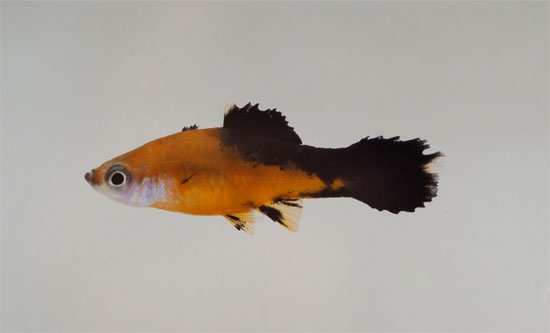Decoded the mackerel genome
(Khoahoc.con.vn) - Scientists at Washington Medical School, St. Louis Louis and other places have deciphered the genome of snapper, a relative of guppies and a popular aquarium fish in families.
In the scientific world, fish are carefully studied about the tendency to develop malignant tumors and other characteristics, more common than mammals, such as flirting with potential partners and giving birth. young
The mackerel with the scientific name Xiphophorus maculatus has many colorful colors, from yellow and silver to iridescent and speckled strips. And when malignant tumors develop, they are easily detected, even with an untrained eye.
'In snakes, malignant tumors often develop as dark spots along the tail and fins,' said Dr. Wesley Warren, a geneticist at the University of Washington Genetics Institute. The snakes are an ideal model to discover many unknown things about cancer, including how, when and where cancer develops in the body as well as the severity of the disease.

Scientists at the University of Washington, University of Wurzburg in Germany and Texas State University led an international research group to analyze the sequence and genome of snapper. Their findings are currently published online in the journal Nautre Genetics.
'Now that we have the mackerel genome in hand, we can discover how genes interact with another gene to cause melanoma' - co-author of the study, PhD. Manfred Scharlt of the University of Würzburg in Germany said. 'Just like in malignant tumors in humans, genes that play a role in pigment cells also affect the development of moles' melanoma.'
The mackerel genome contains about 20,000 genes, equivalent to the number of human genes. But unlike humans or mammals, the mackerel chromosomes, like other fish chromosomes, are still quite intact after about 200 million years of evolution.
"It is very mysterious that why these chromosomes are so similar in structure to other fish during evolution because they live in very different water environments ," Warren said.
Snapper is a species that breeds in large numbers. While most of the fish species spawn, the mackerel gives birth to a baby, usually more than 100 litters.
Comparing the grouper's genes with those in mice and mammals that also gave birth to other babies, the scientists found some mutant genes in this fish involved in the process of premature birth.
'Surprisingly, we found that the mackerel retains some egg yolk-related genes that are often found in spawning fish, and genes involved in placental function and receptor The spermatozoa have shown unique molecular changes , 'said study co-author Dr. Ron Walter of Texas State University.
While human beings are known for their high-level behavior and thinking, groupers and other fish have their own complex behaviors, such as flirting, teaching and running predators, beyond the ability of amphibians, reptiles and other lower-order vertebrates. Observing the genome of grouper, the researchers found that a number of cognitive gene copies in humans and other mammals can be the basis for these behaviors.
'These copies of the gene are kept at a high level in the mackerel, giving them a chance to develop different functions,' explains Dr Warren. 'In this case, we believe that additional copies of the genes give the snakes and other species of fish their ability to develop more complex behaviors, which is a surprise for many animals. low-order backbone '.
- Decoding the genome of oral pathogens
- Successfully decode the genome of soybeans
- Decode the genome bamboo Moso
- Decipher the mysterious life of honey bees
- Decode the 115-year-old woman's genome
- The first complete map of human gene activity
- The genome of the malaria parasite is decoded
- Decoded the watermelon genome
- For the first time, Vietnam has successfully built the Vietnamese genome
- Cheap gene map for individuals
- Herds of fish collect hundreds of fish stuck on the beach after the tide
- The platypus gene reveals the evolutionary secret of mammals
 Animal 'suffering' after hibernation
Animal 'suffering' after hibernation Why do goats climb well?
Why do goats climb well? Scientists were surprised to see chimpanzees eating turtles
Scientists were surprised to see chimpanzees eating turtles Giant catfish died deadly due to drought in Thailand
Giant catfish died deadly due to drought in Thailand Tomatoes will be sweeter and juicier thanks to new technique
Tomatoes will be sweeter and juicier thanks to new technique  Discovered many types of bacteria containing antibiotic resistance genes in Antarctica
Discovered many types of bacteria containing antibiotic resistance genes in Antarctica  The strange evolution of carnivorous plants
The strange evolution of carnivorous plants  Science proves that smart children are mainly thanks to their mothers
Science proves that smart children are mainly thanks to their mothers  Are we more like father or mother?
Are we more like father or mother?  Who wears glasses is smarter than others?
Who wears glasses is smarter than others? 